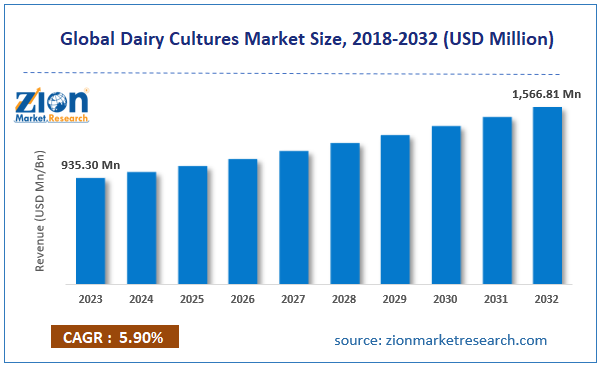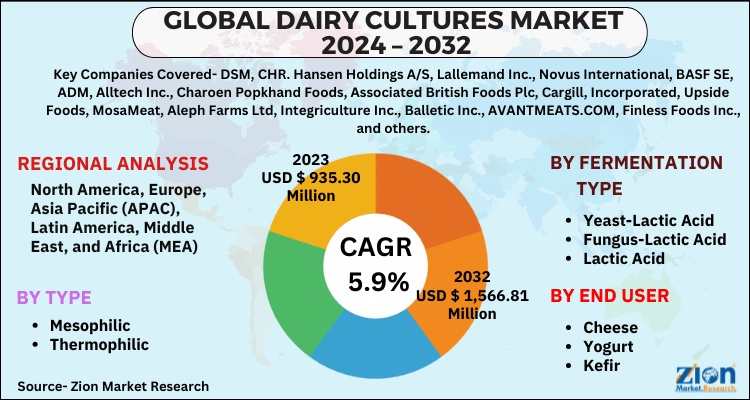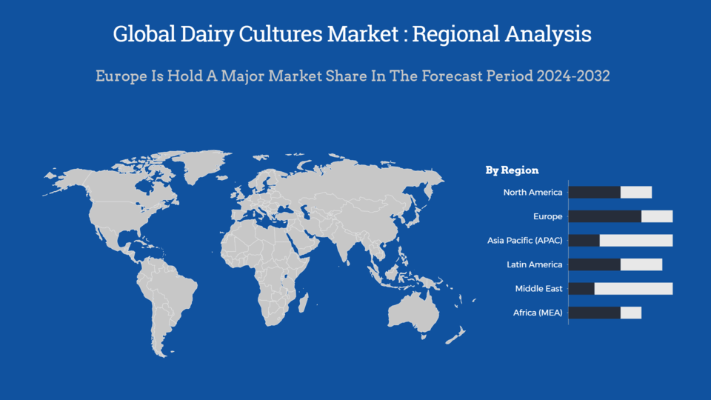Dairy Cultures Market Size, Share, Trends, Growth 2032

Dairy Cultures Market By Type (Mesophilic and Thermophilic), By Fermentation Type (Yeast-Lactic Acid, Fungus-Lactic Acid, and Lactic Acid), By End User (Cheese, Yogurt, Kefir, and Others), and By Region - Global and Regional Industry Overview, Market Intelligence, Comprehensive Analysis, Historical Data, and Forecasts 2024 - 2032
| Market Size in 2023 | Market Forecast in 2032 | CAGR (in %) | Base Year |
|---|---|---|---|
| USD 935.30 million | USD 1566.81 million | 5.9% | 2023 |
Global Dairy Cultures Market: Industry Perspective
The global dairy cultures market is experiencing robust growth, projected to expand from approximately USD 935.30 million in 2023 to 1566.81 million by 2032, at a CAGR of 5.9%. This surge is driven by increasing consumer demand for probiotic-rich and functional dairy products like yogurt, kefir, and cheese, which promote gut health and overall wellness. The market is segmented by fermentation types—lactic acid, yeast-lactic acid, and fungus-lactic acid—with the yeast-lactic acid segment leading due to its widespread use in fermented dairy products. Thermophilic cultures dominate the type segment, particularly in cheese production, while mesophilic cultures are gaining traction for their application in products like buttermilk. Asia-Pacific is the fastest-growing region, fueled by rising disposable incomes and a shift toward health-conscious diets. Key industry players such as Chr. Hansen Holding A/S, DuPont, DSM, and Lallemand Inc. are focusing on innovation and sustainability to meet evolving consumer preferences.
Global Dairy Cultures Market: Overview
Yeast and other bacteria are the most common microorganisms utilized in dairy culture, while other microorganisms are also occasionally employed. By improving the flavor, texture, and quality of milk, these cultures are essential to producing goods like yogurt and cheese. Lactose is fermented into lactic acid by starter cultures, which are made up of particular microbes. These cultures add distinctive qualities to the finished dairy product. To create mother cultures for wider usage in dairy processing, a commercial culture, sometimes referred to as a master culture, is obtained from a laboratory. Fermentation of milk with lactic acid bacteria produces cultured dairy products like yogurt, which have unique flavors and health advantages.
Global Dairy Cultures Market: Growth Drivers
Growing health benefits associated with dairy product drives market growth
Producers of high-quality dairy goods, particularly dairy starting culture components, are under pressure to meet consumer demand for safe dairy products and growing market awareness. The taste, texture, and color of dairy products are enhanced by dairy starting culture, giving them the right consistency. The dairy culture market is anticipated to rise significantly over the forecast period due to an increase in consumer demand for premium dairy products. Furthermore, the health benefits of adding starter microorganisms to dairy products—such as immunity system strengthening, constipation relief, lower serum cholesterol, anti-carcinogenic effect, and antiallergenic properties—are anticipated to drive the growth of the global dairy culture market in the near future.
Restraints
High production costs and competition from plant-based alternatives hinder market growth
Sophisticated technology and stringent quality control procedures are necessary for the creation of high-quality dairy cultures, which raises manufacturing costs. Dairy products can become more costly and possibly lose their competitiveness in the market if these expenses are passed on to customers. The market for dairy cultures is also under a big threat from the rising popularity of plant-based dairy substitutes including oat, soy, and almond products. Consumer demand is being shifted away from dairy-based goods by these substitutes, which frequently do not employ traditional dairy cultures.
Opportunities
Growing product launches offer a lucrative opportunity for market growth
The growing product launch is expected to offer a lucrative opportunity to the Dairy Cultures market over the projected period. For instance, in September 2023, a new generation of starter cultures for very mild yogurts called Delvo®Fresh Pioneer was introduced by DSM-Firmenich, a global pioneer in nutrition, health, and beauty. This launch meets the demand of yogurt makers for high-quality ingredients, robust production methods, and constant mildness throughout shelf life by enabling outstanding pH stability during processing and throughout the product's lifespan. This range, which is a component of DSM-Firmenich's toolset for fermented dairy, is the outcome of the business's proficiency in biotechnology and dedication to purpose-led research. Compared to previous generations for mild yogurt recipes, yogurt pH is significantly more stable with this generation of cultures, lasting up to 60 days in cold storage.
Challenges
Fluctuation in milk prices poses a major challenge to market expansion
An important component of dairy products, raw milk can fluctuate in price depending on the price of feed, the state of the weather, and agricultural regulations. Uncertainties in the dairy culture industry might result from variations in milk prices, which can impact the total cost of manufacturing cultured dairy products. Therefore, the fluctuation in milk prices is expected to pose a major challenge to the market growth.
Key Insights
- As per the analysis shared by our research analyst, the global Dairy Cultures Market is estimated to grow annually at a CAGR of around 5.9% over the forecast period (2024-2032).
- In terms of revenue, the global Dairy Cultures Market size was valued at around USD 935.30 Million in 2023 and is projected to reach USD 1,566.81 Million by 2032.
- Based on the type, Thermophilic cultures dominate the dairy cultures market due to their crucial role in producing fermented dairy products like yogurt and cheese. These cultures thrive at higher temperatures (40–45°C) and are essential for fast and efficient fermentation processes. Key thermophilic strains such as Lactobacillus delbrueckii and Streptococcus thermophilus are widely used to enhance flavor, texture, and shelf life while ensuring consistent product quality. The rising demand for yogurt and cheese, particularly Greek yogurt and hard cheeses, accelerates the adoption of thermophilic cultures.
- Based on the fermentation type, Yeast-lactic acid fermentation is the leading segment in the dairy cultures market. This dominance is attributed to the widespread adoption of yeast-lactic acid fermentation in the production of various dairy products, including yogurt and cheese. Consumers' growing preference for these fermented dairy items, driven by their unique flavors and health benefits, has fueled the demand for yeast-lactic acid cultures. Moreover, advancements in fermentation technologies and the increasing popularity of probiotic-rich foods have further propelled the market for this specific fermentation type.
- Based on the end user, The cheese segment holds the largest share in the dairy cultures market. The popularity of cheese can be attributed to its versatility in culinary applications, appealing taste profiles, and widespread consumer acceptance. As a staple ingredient in various cuisines worldwide, cheese continues to experience robust demand. The sustained dominance of the cheese segment reflects its enduring popularity among consumers and its integral role in the food industry.
- Based on the region, Europe leads the dairy cultures market, accounting for the largest share due to its rich heritage in the consumption of dairy products. Countries like France, Italy, the UK, and Scandinavia are among the top dairy consumers. The growing health consciousness among consumers, particularly about probiotics and gut health benefits, further fuels demand for cultured dairy products like yogurt and kefir. Additionally, regulations in Europe contribute to the development and marketing of functional foods, ensuring that dairy products enriched with beneficial cultures are safe and of high quality
Global Dairy Cultures Market: Report Scope
| Report Attributes | Report Details |
|---|---|
| Report Name | Dairy Cultures Market |
| Market Size in 2023 | USD 935.30 Million |
| Market Forecast in 2032 | USD 1,566.81 Million |
| Growth Rate | CAGR of 5.9% |
| Number of Pages | 212 |
| Key Companies Covered | DSM, CHR. Hansen Holdings A/S, Lallemand Inc., Novus International, BASF SE, ADM, Alltech Inc., Charoen Popkhand Foods, Associated British Foods Plc, Cargill, Incorporated, Upside Foods, MosaMeat, Aleph Farms Ltd, Integriculture Inc., Balletic Inc., AVANTMEATS.COM, Finless Foods Inc., and others. |
| Segments Covered | By Type, By Fermentation Type, By End User, and By Region |
| Regions Covered | North America, Europe, Asia Pacific (APAC), Latin America, Middle East, and Africa (MEA) |
| Base Year | 2023 |
| Historical Year | 2018 to 2022 |
| Forecast Year | 2024 - 2032 |
| Customization Scope | Avail customized purchase options to meet your exact research needs. Request For Customization |
Global Dairy Cultures Market: Segmentation
The global dairy culture industry is segmented based on type, fermentation type, end-user, and region. All the segments have been analyzed based on present and future trends and the market is estimated from 2024 to 2032.
Based on the type, the global dairy cultures market is segmented into mesophilic and thermophilic. The thermophilic segment is expected to dominate the market over the forecast period. Several reasons contribute to the segment's prominence. Food processing, biofuel manufacture, and bioremediation are a few industrial activities that can benefit from the use of thermophilic enzymes because they are extremely stable and active at high temperatures. Comparing thermophilic and mesophilic enzymes, the former frequently shows greater substrate selectivity and catalytic efficiency. The preference for thermophilic enzymes is expected to last throughout the forecast period, fueling their dominance in the market as industries continue to demand more sustainable and efficient operations. Further bolstering their sustained dominance in the global market is the growing use of thermophilic enzymes in a wide range of industrial applications.
Based on the fermentation type, the global dairy cultures industry is bifurcated into yeast-lactic acid, fungus-lactic acid, and lactic acid. The yeast-lactic acid segment is expected to hold a significant market share over the projected period. This can be ascribed to the extensive use of yeast-lactic acid fermentation in manufacturing cheese and yogurt, among other dairy products. The demand for yeast-lactic acid cultures has increased due to consumers' rising desire for these fermented dairy products due to their distinct flavors and health advantages. The need for this particular type of fermentation has also been driven by improvements in fermentation technologies and the growing acceptance of foods high in probiotics.
Based on the end user, the global dairy culture market is segmented into cheese, yogurt, kefir, and others. The cheese segment is expected to capture the largest market share over the projected period. Cheese’s taste profiles are pleasant, it is widely accepted by consumers, and it is versatile in culinary applications that make it popular. Cheese is still in high demand because it is a basic component of many different cuisines around the world. Cheese's continued appeal among consumers and its crucial position in the food sector is reflected in its sustained dominance of the market. Cheese's role as a major driver of the worldwide dairy market is cemented by the trend's predicted continuation, which highlights the persistent customer preference for the product.
The regional segment includes the current and forecast demand for North America, Europe, Asia Pacific, Latin America, and the Middle East and Africa.
Global Dairy Cultures Market: Regional Analysis
Asia Pacific leads the market over the projected period
The Asia Pacific is expected to lead the global dairy cultures market growth during the forecast period. Technological developments, strong economic growth, and rising consumer demand for dairy culture are the main factors driving market expansion. Because of ongoing innovations, supportive policies from the government, and a growing middle class, the area is likely to continue to dominate the market during the forecast period. Businesses frequently adjust their plans to account for local differences. Therefore, this section is essential for focused advertising, positioning products, and general business planning. Comprehending regional disparities enables stakeholders to make knowledgeable selections and adjust to the varied market circumstances that are commonplace worldwide. Thus, this is expected to drive the dairy culture market growth in the region.
Global Dairy Cultures Market: Competitive Analysis
The global dairy cultures market is dominated by players like:
- DSM
- CHR. Hansen Holdings A/S
- Lallemand Inc.
- Novus International
- BASF SE
- ADM
- Alltech Inc.
- Charoen Popkhand Foods
- Associated British Foods Plc
- Cargill
- Incorporated
- Upside Foods
- MosaMeat
- Aleph Farms Ltd
- Integriculture Inc.
- Balletic Inc.
- AVANTMEATS.COM
- Finless Foods Inc.
Global Dairy Cultures Market: Segmentation Analysis
The global dairy cultures market is segmented as follows:
By Type
- Mesophilic
- Thermophilic
By Fermentation Type
- Yeast-Lactic Acid
- Fungus-Lactic Acid
- Lactic Acid
By End User
- Cheese
- Yogurt
- Kefir
- Others
Global Dairy Cultures Market: Regional Segment Analysis
- North America
- The U.S.
- Canada
- Europe
- France
- The UK
- Spain
- Germany
- Italy
- Rest of Europe
- Asia Pacific
- China
- Japan
- India
- South Korea
- Southeast Asia
- Rest of Asia Pacific
- Latin America
- Brazil
- Mexico
- Rest of Latin America
- Middle East & Africa
- GCC
- South Africa
- Rest of Middle East & Africa
Table Of Content
Methodology
FrequentlyAsked Questions
Yeast and/or bacteria are the most common microorganisms utilized in dairy culture, while other microorganisms are also occasionally employed. By improving the flavor, texture, and quality of milk, these cultures are essential to the production of goods like yogurt and cheese. Lactose is fermented into lactic acid by starter cultures, which are made up of particular microbes. These cultures add distinctive qualities to the finished dairy product. To create mother cultures for wider usage in dairy processing, a commercial culture, sometimes referred to as a master culture, is obtained from a laboratory. Fermentation of milk with lactic acid bacteria produces cultured dairy products like yogurt, which have unique flavors and health advantages.
The dairy cultures market is being driven by several factors, such as growing demand for healthy products, health and hygiene concerns, advancements in technology, increasing collaboration, rising product launches, and others.
According to the report, the global dairy culture market size was worth around USD 935.30 million in 2023 and is predicted to grow to around USD 1566.81 million by 2032.
The global dairy culture market is expected to grow at a CAGR of 5.9% during the forecast period.
The global dairy culture market growth is expected to be driven by the Asia Pacific. It is currently the world’s highest revenue-generating market due to the rising health and wellness trends.
The global dairy cultures market is dominated by players like DSM, CHR. Hansen Holdings A/S, Lallemand Inc., Novus International, BASF SE, ADM, Alltech Inc., Charoen Popkhand Foods, Associated British Foods Plc, Cargill, Incorporated, Upside Foods, MosaMeat, Aleph Farms Ltd, Integriculture Inc., Balletic Inc., AVANTMEATS.COM and Finless Foods Inc. among others.
The dairy culture market report covers the geographical market along with a comprehensive competitive landscape analysis. It also includes cash flow analysis, profit ratio analysis, market basket analysis, market attractiveness analysis, sentiment analysis, PESTLE analysis, trend analysis, SWOT analysis, trade area analysis, demand & supply analysis, Porter’s five forces analysis, and value chain analysis.
HappyClients
Zion Market Research
Tel: +1 (302) 444-0166
USA/Canada Toll Free No.+1 (855) 465-4651
3rd Floor,
Mrunal Paradise, Opp Maharaja Hotel,
Pimple Gurav, Pune 411061,
Maharashtra, India
Phone No +91 7768 006 007, +91 7768 006 008
US OFFICE NO +1 (302) 444-0166
US/CAN TOLL FREE +1 (855) 465-4651
Email: sales@zionmarketresearch.com
We have secured system to process your transaction.
Our support available to help you 24 hours a day, five days a week.
Monday - Friday: 9AM - 6PM
Saturday - Sunday: Closed







